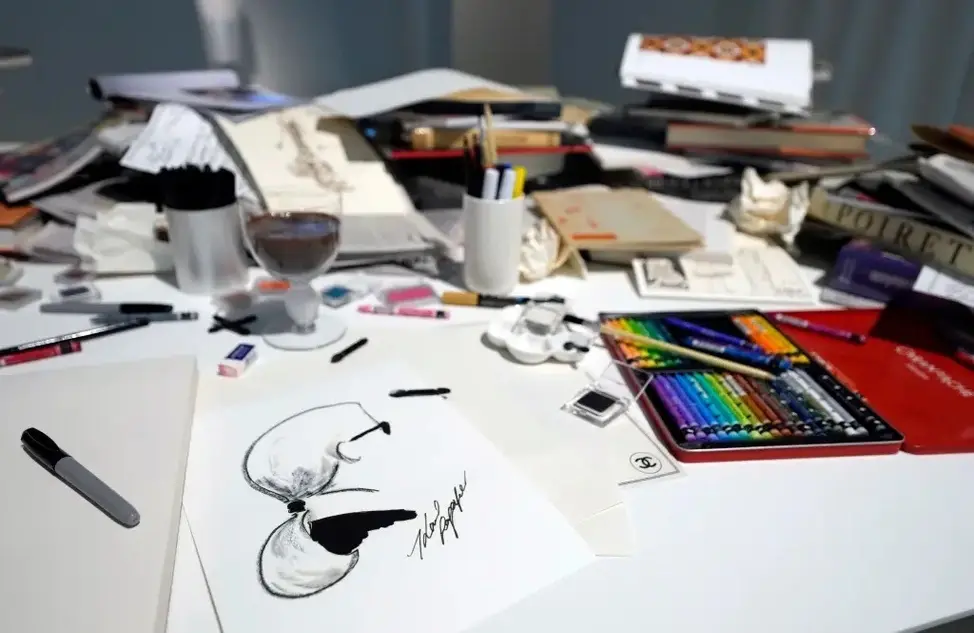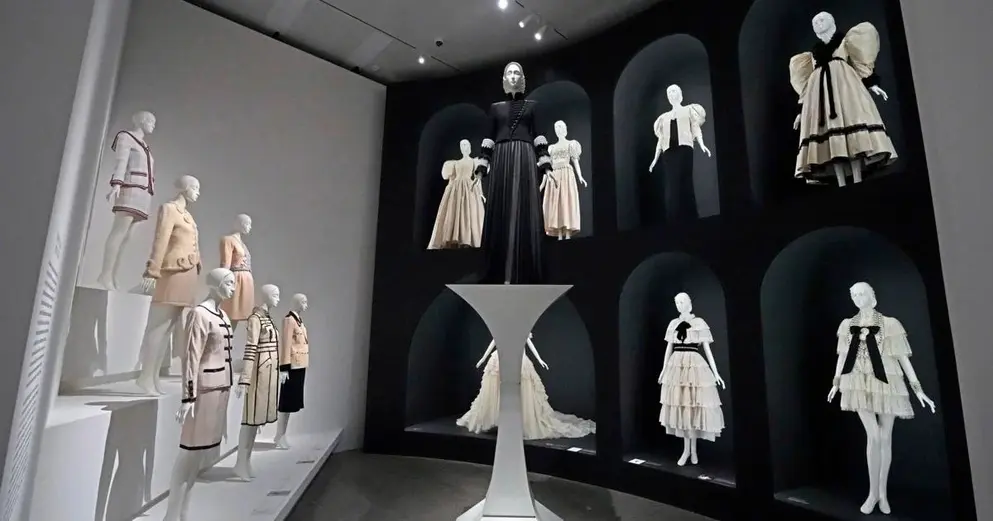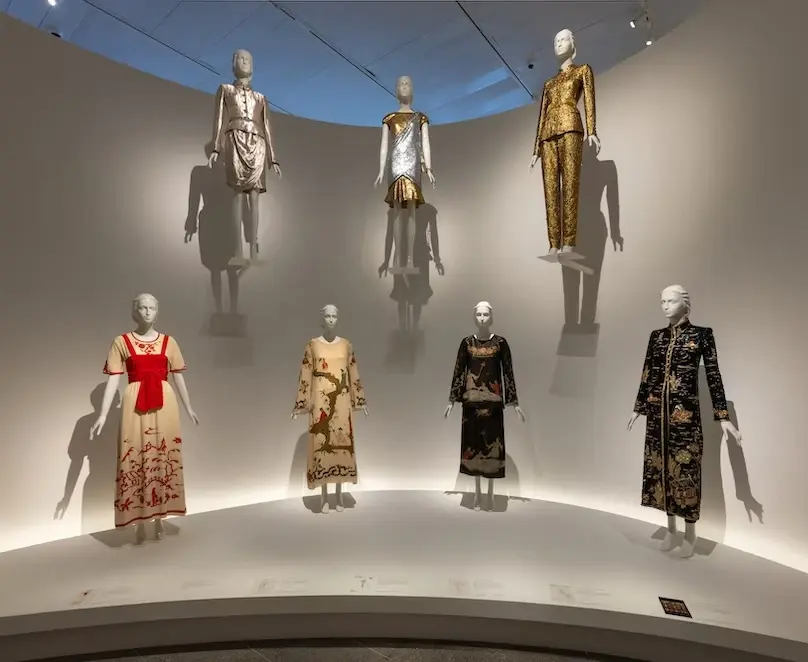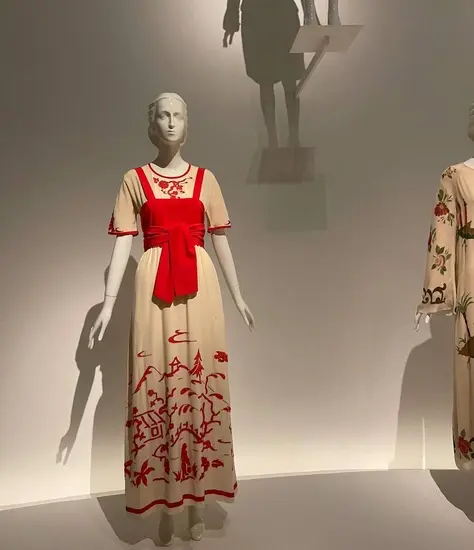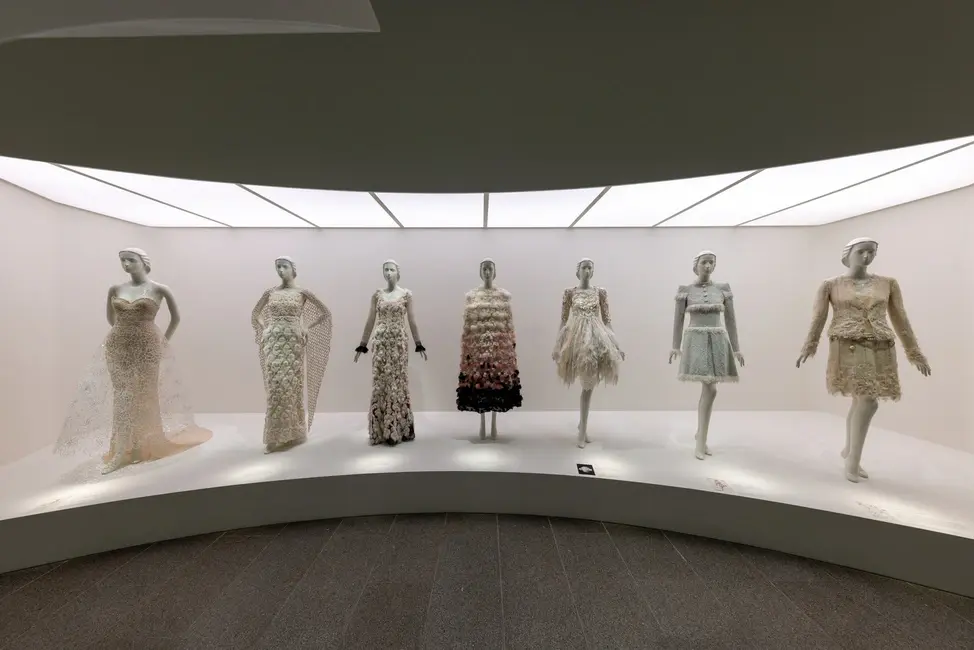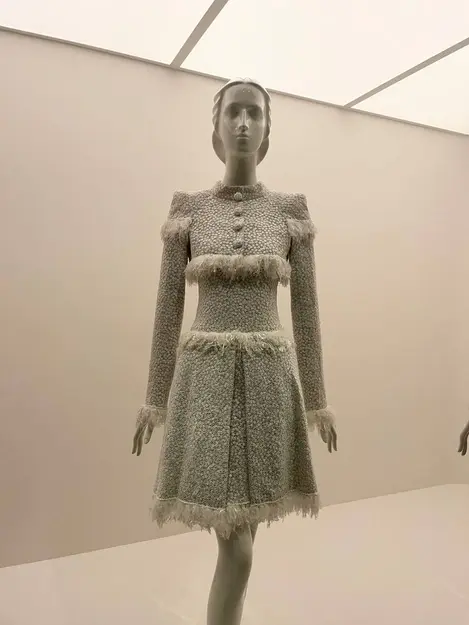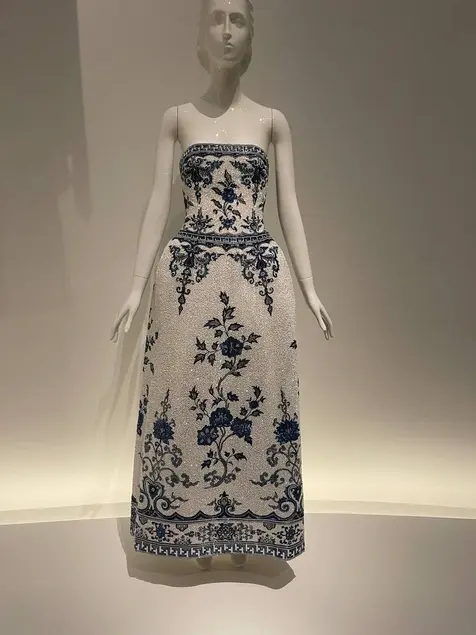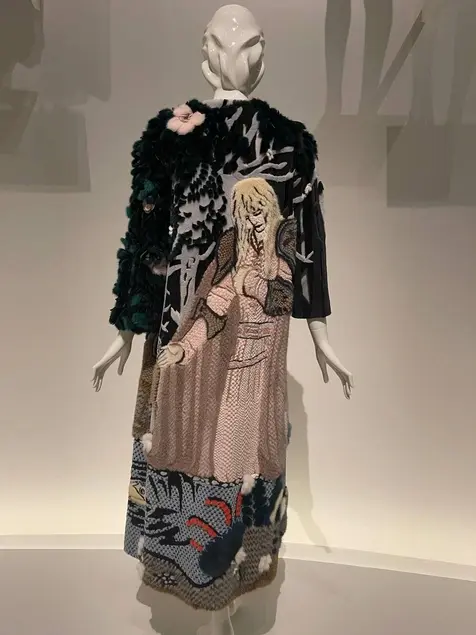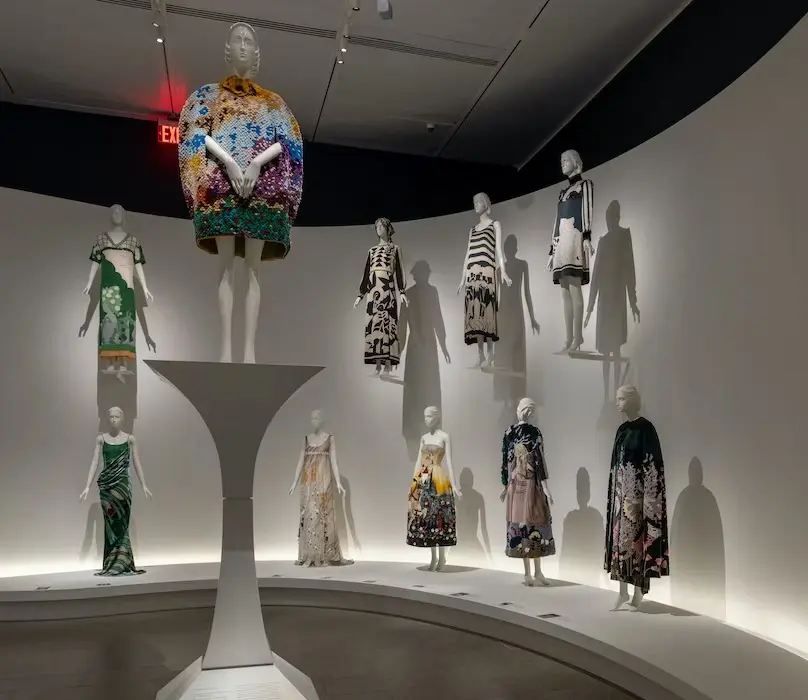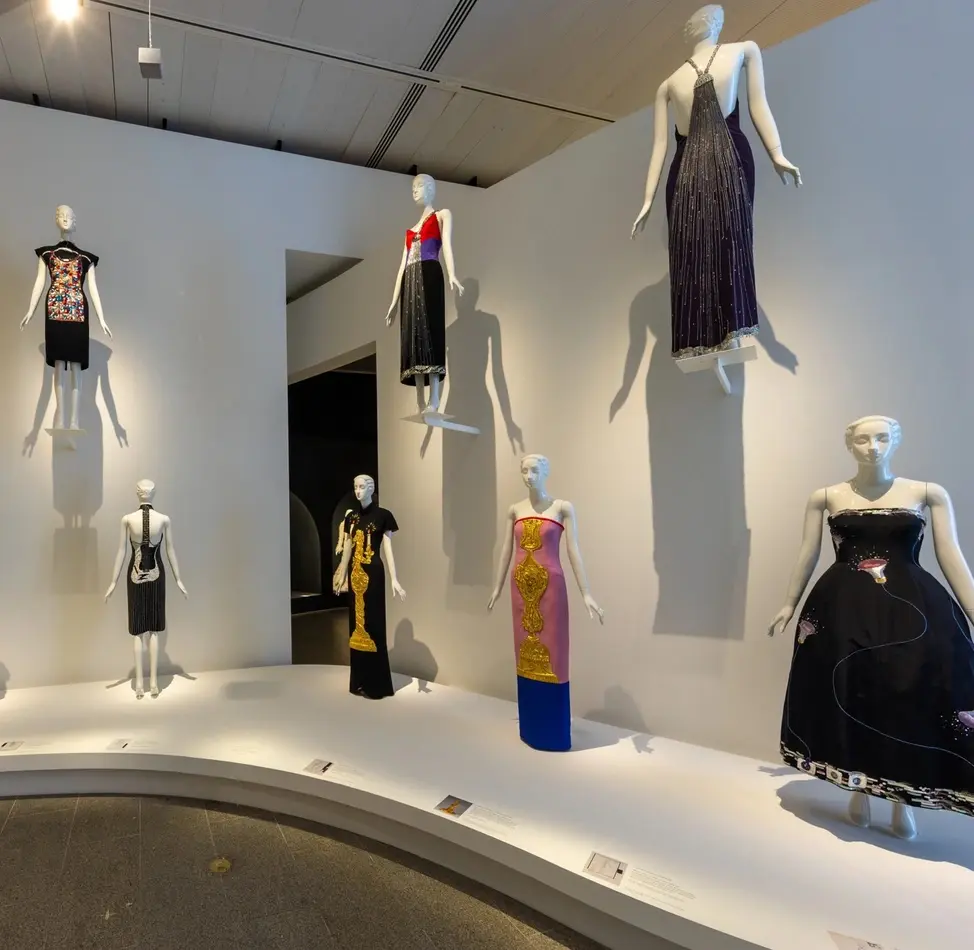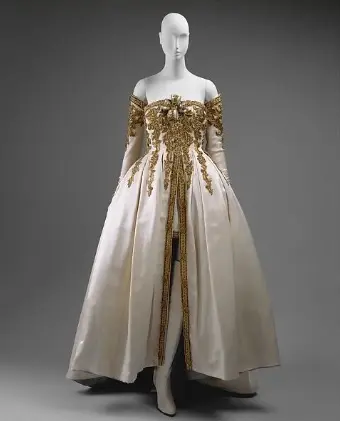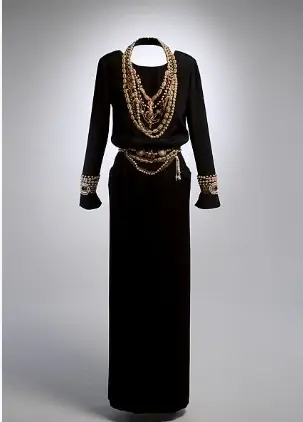Over 150 works showcasing Karl Lagerfeld’s designs for renowned brands like Balmain, Patou, Chloé, Fendi, Chanel, and his own label will be exhibited. The collection includes his distinctive fashion illustrations created with a thick Sharpie. Spanning 64 years of his career, from the 1950s to his final collections in 2019, the exhibition explores Lagerfeld’s working methodology and the evolution of his fashion designs. Andrew Bolton, head curator of the Costume Institute, highlighted the transition from two-dimensional to three-dimensional fashion in Lagerfeld’s work.
The exhibit features nine categories showcasing Karl Lagerfeld’s distinct “lines” created with his pen. These include the Ornamental Line, highlighting his playful use of flowers and decorative elements. The Structural Line showcases his iconic Chanel coats, known for their sturdy and practical designs. The Explosion Line captures Lagerfeld’s flair for adding pizzazz to the runway with gold-embellished dresses.
Fashion designer Karl Lagerfeld found inspiration in the Romantic era, which spanned from the late 1700s to the 1850s in Europe. He was particularly drawn to its idealization of nature, evident in his romantic line’s garments. This collection showcased the distinctive puffed gigot sleeves of the 1830s and the characteristic dome-shaped crinoline skirt of the 1850s. Lagerfeld also drew influence from Franz Xaver Winterhalter’s paintings, particularly the portraits of Empress Eugénie of France and Empress Elisabeth (Sissi) of Austria, who were iconic figures of royal style during the Second Empire. Eugénie, in particular, became known as “La Reine Crinoline” due to her association with the opulent crinoline fashions.
In contrast to the romantic line, Lagerfeld’s military line featured designs inspired by the formal aspects of military uniforms rather than their symbolic meaning. The ornamental components included braids reminiscent of hussar uniforms, tabs inspired by European military dress of the 18th and early 19th centuries, and large pockets with scalloped flaps referencing World War I uniforms. Lagerfeld’s creativity extended beyond military influences, as he even collaborated with the Fendi sisters in 1983 to redesign the uniforms of Roman policewomen. Throughout his designs, Lagerfeld demonstrated his ability to juxtapose the buoyant and sentimental costumes of Romantic heroines with the austere and rational uniforms of military heroes, showcasing his ingenuity in merging diverse sources of inspiration.
Lagerfeld’s rococo tendencies found expression in his enthusiastic embrace of Orientalism, reimagining and expanding Western fashion through the adaptation of Eastern ideas and styles. His Orientalist impulses drew from the European imaginary, incorporating elements of picturesque Cathay and traditional Indian dress influenced by British imperial rule. Additionally, Lagerfeld’s classicism manifested in references to ancient Greek women’s apparel, such as the chiton, peplos, and himation, as seen in his designs. One notable creation was the white silk jersey dresses he collaborated on with the Fendi sisters for the 1990 FIFA World Cup, inspired by the peplos and adorned with fibulae-like pins at the shoulders. These dresses were accompanied by headdresses reflecting architectural landmarks of Rome, complementing the overall aesthetic.
Lagerfeld’s artistic vision encompassed both the handmade and the machine-made, blurring the traditional boundaries between haute couture and ready-to-wear fashion. Rather than viewing the hand and the machine as opposing forces, Lagerfeld saw them as complementary tools that enriched and advanced his craft. He skillfully utilized these tools to either reinforce or challenge the cultural connotations and hierarchical implications associated with the hand/machine dichotomy. This included examining the notions of exclusivity, spontaneity, and individuality associated with handwork, as well as the perceived inferiority, dehumanization, and homogenization often attributed to machine production.
The serpentine artisanal line showcased Lagerfeld’s creations from his haute fourrure collections for Fendi, as well as his haute couture and métiers d’art collections for Chanel. These garments not only celebrated but fetishized handwork, emphasizing the artistry of specialized workshops dedicated to dressmaking and applied decoration. Lagerfeld’s appreciation for the meticulous craftsmanship of the “petites mains” was evident in these designs. In contrast, the straight mechanical line embraced the technical and creative potential of industrial technology. Lagerfeld explored fabric development and garment construction techniques such as laser cutting and selective laser sintering, an additive manufacturing process that uses a laser to solidify powdered materials. Through this exploration, Lagerfeld demonstrated his ability to harness the capabilities of modern technology in fashion creation.
Lagerfeld’s enduring stylistic fascination resided in the juxtaposition of traditional couture propriety with the transgressive allure of cutting-edge street fashion. The garments showcased in this gallery embody the clash between these contrasting forces, as Lagerfeld delighted in staging confrontations between the establishment and the anti-establishment. The pieces in the serpentine canonical line exuded refined elegance, asserting their status while enhancing it within the intimate and exclusive setting of a salon. Some designs cleverly incorporated trompe l’oeil details, paying homage to Gabrielle Chanel’s daring approach of mixing real and artificial jewelry, which once challenged conventional notions of taste. Notably, an ensemble from Chanel’s autumn/winter 1996-97 haute couture collection featured a coat meticulously crafted from black organza with applied silk tulle strips, cleverly gathered, crocheted, and dyed to imitate the luxurious appearance of a mink fur coat—a subversive reinterpretation of wealth and power in sartorial symbolism.
The countercultural line, on the other hand, represented Lagerfeld’s fascination with the “trickle-up” movement of fashion, where styles originating from the streets ascended into the realm of high fashion. In contrast to the canonical line’s horizontal dissemination among individuals of similar social and economic standing, the countercultural line celebrated the influence of street fashion on haute couture. Lagerfeld gleefully embraced this reversal, drawing inspiration from various countercultural styles such as punk, surfer, and hip-hop. These references to the street manifested in designs symbolizing youthfulness, including the iconic miniskirt. Lagerfeld’s approach reflected his belief in fashion as an enlightening realm of ideas, promoting a classless approach that went beyond the confines of social fashion, championing true style that transcended societal boundaries.
Lagerfeld’s discerning taste extended beyond the realm of fashion and encompassed a wide range of art styles in his collection. From Art Deco to Memphis, Biedermeier to the Wiener Werkstatte, his eclectic collecting practices mirrored his diverse fashion inspirations. However, his true passion lay in the arts of the eighteenth century, particularly the refined style of Louis XV, which Lagerfeld deemed the epitome of elegance and restraint. This affinity for the eighteenth century translated into his fashion designs, as evidenced by the garments in the serpentine ornamental line. These pieces drew inspiration from a rich array of decorative arts from the era, including Jean-Baptiste Pillement’s etchings, Meissen porcelain with intricate pierced borders, delicate Vincennes porcelain flowers, a captivating blue-and-white lacquered corner cabinet, and a Chinese Qing dynasty vase adorned with blue-and-white motifs.
In contrast to the ornamental line’s rococo flourishes, the structural line showcased Lagerfeld’s modernist precision and meticulous approach to tailoring. This collection featured suits and coats from his Chanel line, shedding light on a key distinction between Lagerfeld and the house’s founder, Gabrielle Chanel. While Chanel primarily focused on the finishing touches of tailoring, Lagerfeld placed greater emphasis on tailoring construction itself. The garments also revealed Lagerfeld’s preoccupation with specific anatomical details, particularly the shoulders and the side of the ribs, specifically the serratus anterior muscle, also known as the boxer’s muscle or, in Lagerfeld’s whimsical description, the “chute du foie” or the “fall of the liver.” This attention to anatomical nuances showcased Lagerfeld’s meticulous approach to design and his desire to explore the intricacies of the human form within his fashion creations.
The floral line in Lagerfeld’s designs spotlights the exquisite art of “parurier floral,” dedicated to the creation of artificial flowers. These intricate floral representations symbolize the triumph of fashion’s artistic prowess, allowing Lagerfeld to capture and emulate nature’s abundant beauty. Rather than serving as mere embellishments, these flowers play a central role, acting as enabling principles within his garments. Lagerfeld’s exploration of applied decoration finds its fullest expression in the floral line, where a captivating array of botanical representations showcases his limitless creativity and dedication to detail.
In striking contrast, the geometric line takes a different artistic direction, celebrating the elegance of simplicity and two-dimensional planes. Influenced by modern art movements such as Cubism, Orphism, and Constructivism, the ensembles in this collection feature graphic forms that exude a sense of economy and precision. One notable inspiration is Pop Art, evident in the “Alphabet” dress from Lagerfeld’s spring/summer 2004 collection under his eponymous label. Hand-painted with letters and numbers in the iconic Futura typeface designed by Paul Renner in 1927, the dress reflects the minimalist aesthetic of the Bauhaus movement. With its clean lines and geometric shapes, including near-perfect circles, squares, and triangles, the garment embodies a modernist sensibility that defines this group of garments, showcasing Lagerfeld’s ability to embrace diverse artistic influences.
Lagerfeld firmly believed that fashion served as a means of self-expression, reflecting the prevailing artistic and cultural spirit of the time. Despite this, he maintained a strong stance that fashion was distinct from art and that fashion designers should not be considered artists. Lagerfeld viewed fashion as a practical and commercial realm, operating within its own system and culture separate from the realm of art. Nevertheless, he frequently drew inspiration and knowledge from the world of fine art. The figurative and abstract lines in Lagerfeld’s designs exemplify his connection between art and fashion, encompassing both narrative and non-narrative elements, as well as representations and non-representations.
Lagerfeld’s inclination towards figurative elements found notable expression in his creations for Chloe and Fendi. For instance, his haute fourrure collection for Fendi in the autumn/winter of 2016-17 drew inspiration from Kay Nielsen’s illustrations in the 1914 book “East of the Sun and West of the Moon,” accompanied by commissioned illustrations from Kate Baylay and Charlotte Gastaut. His designs for Chloe often incorporated influences from Art Deco and Art Nouveau, exemplified by a dress from his autumn/winter 1967-68 collection featuring a hand-painted image inspired by British illustrator Aubrey Beardsley, executed by Nicole Lefort. The abstract line builds upon the artistic influences seen in the preceding geometric line, with Lagerfeld’s designs referencing Cubism and Constructivism. These art movements held a particular fascination for Lagerfeld due to their abstraction, mirroring his own open-minded and generous approach to creativity.
Lagerfeld possessed a keen and adaptable understanding of fashion history, skillfully incorporating it into his designs by juxtaposing the past and present. He believed in assimilating the past into the present, but only if it resonated with the spirit of the times. His Chanel collections of the 1980s exemplify this promiscuous historicism, a period when postmodernism brought a heightened awareness of history into contemporary consciousness. While Lagerfeld explored fashion from various eras, his focus primarily centered on the dress styles of European royal courts from the seventeenth to the nineteenth centuries. Even his futuristic vision drew inspiration from history, as demonstrated in the futuristic line featuring garments inspired by the 1960s space exploration era, driven by Cold War aspirations and competition. An ensemble from Fendi’s autumn/winter 2001-2 collection embodies the optimism and idealism of the new millennium, reminiscent of Pierre Cardin’s “Cosmos” outfits from 1964, symbolizing the hope and excitement of the space race.
Ensemble, 2003-4 métiers d’art Jacket of ivory silk crepe overlaid with ivory cashmere knit, embroidered by Lesage with silver silk-and-metal thread and clear sequins, and trimmed with ivory silk tulle, ivory silk chiffon, clear seed beads, and bugle beads; dress of ivory cashmere knit and silk crepe overlaid with ivory cashmere knit, embroidered by Lesage with silver silk-and-metal thread and clear sequins, and trimmed with ivory silk tulle, ivory silk chiffon, clear seed beads, and bugle beads; belt of gold metal and simulated pearls
Sketch of CHANEL jacket, 2003-4 métiers d’art. Courtesy CHANEL
